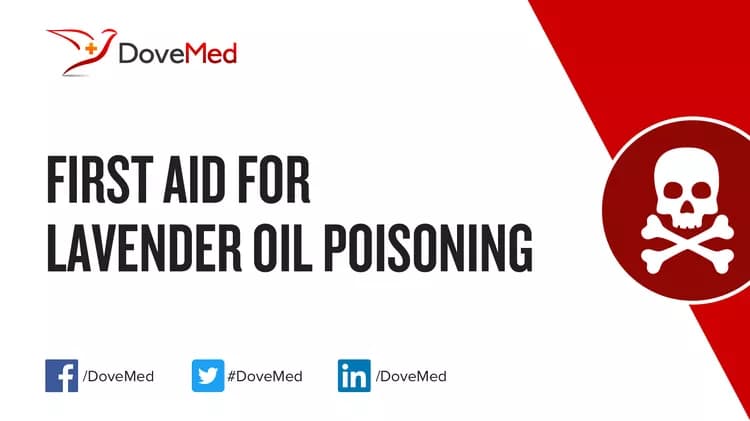What is Lavender Oil Poisoning?
- Lavender oil is an aromatic oil that is derived from the flowers of the lavender plant. The oil is used for making perfume and as an agent in aromatherapy
- Lavender Oil Poisoning is the accidental or intentional intake (swallowing) of the compound
- The condition is diagnosed based upon the clinical history, combination of signs and symptoms, and additional tests (that may include, in some cases, radiological studies and laboratory tests)
Lavender Oil Poisoning may be also referred to as Lavender Oil Toxicity.
What are the Causes of Lavender Oil Poisoning?
- Lavender Oil Poisoning is caused by the intake or ingestion of compounds containing lavender oil. The oil may also be accidentally spilled into the eye affecting vision
- This intake could be accidental, or in some cases intentional, to bring self-harm
- The poison contained in the oil is called acetate ester of linalool (a naturally-derived form of terpene alcohol)
Note: The compound can interact with other prescribed or non-prescribed medications in the body. Such interactions may enhance the therapeutic effects of other medications being taken, resulting in undesired side effects.
What are the Signs and Symptoms of Lavender Oil Poisoning?
The signs and symptoms of Lavender Oil Poisoning can vary from one individual to another. It may be mild in some and severe in others. Several systems of the body, such as the digestive system, nervous system, skin, and ENT may be affected.
The signs and symptoms of Lavender Oil Poisoning may include
- Mouth, throat, and food-pipe may have burning sensation or burns. This may affect the eye, nose, and ears too
- Breathing difficulties due to substance ingestion
- Vision abnormalities including blurry vision
- Skin rashes
- Nausea and vomiting
- Blood in stool; watery diarrhea
- Pain in the abdomen/stomach
- Confusion
- Low response level
How is First Aid administered for Lavender Oil Poisoning?
First Aid tips for Lavender Oil Poisoning:
- If the individual with Lavender Oil Poisoning is experiencing life-threatening symptoms, call 911 (or your local emergency help number) immediately
- Call the Poison Control Center at 1-800-222-1222 (or your local poison control center) for further instructions
- Provide them with information such as the compound taken, quantity and time of ingestion, age, weight and general health status of affected individual
- Confirm that the airways are protected; also, ensure breathing and the presence of pulse
- Unless instructed by a healthcare professional, DO NOT induce vomiting in the affected individual
- Following an ingestion of the substance, immediately give milk/water to drink, based on recommendations of the healthcare personnel
- In case of symptoms that indicate difficulty in swallowing including vomiting or decreased alertness, do not give anything by way of mouth
- If involvement of the eye has occurred, then wash thoroughly with copious amounts of water (for at least 15 minutes)
- Take individual to emergency room (ER) for further treatment
- Always try to take the compound bottle/container to the ER
The emergency medical health professional might perform the following steps towards treating the condition:
- Medically manage symptoms, such as abnormal heart rate and seizures
- Provide breathing support, if necessary
- Gastric lavage for elimination of the substance from the stomach (irrigation using special solutions)
- Administer activated charcoal to avoid absorbance of the substance in the body
- Administer laxatives for elimination of the substance from the body
- Wash skin and eyes repeatedly and thoroughly (irrigation), to eliminate any remaining hazardous compound
- Administer fluids by an intravenous drip line
Who should administer First Aid for Lavender Oil Poisoning?
First aid for Lavender Oil Poisoning is administered by healthcare professionals.
- The individual who is affected, or someone near, should call 911 for emergency assistance (or the local emergency number)
- They should also call the poison control center at 1-800-222-1222 (or the local poison control center) and follow instructions
What is the Prognosis of Lavender Oil Poisoning?
- The prognosis of Lavender Oil Poisoning is dependent on the amount of substance consumed, time between poisoning and treatment, severity of the symptoms, as well as general health status of the patient
- If the individual can recover from the symptoms early, through appropriate early medication and support, the outcome is generally good. However, the prognosis may be affected, if a severe allergic reaction develops in the individual
- Lavender oil ingestion can cause more severe symptoms in children than adults, in whom the oil is not known to cause significant complications of poisoning
In general, toxicities are common situations in the emergency departments. A majority of the cases are often not fatal, when appropriate treatment is given.
How can Lavender Oil Poisoning be Prevented?
Lavender Oil Poisoning can be prevented by:
- Always follow instructions for usage of any health or cosmetic products
- Keeping cosmetics, medications, and other healthcare products out of reach of children in child-proof containers
- Being aware of basic first aid steps in case of an emergency (such as inadvertent poisoning)
What are certain Crucial Steps to be followed?
- Call 911 (or your local emergency number) for emergency assistance, if symptoms are life-threatening
- Call Poison Control Center at 1-800-222-1222 (or the local poison control center) and follow the recommend steps
- It would be helpful if the following information is readily available:
- Type, amount and time of consumption of the substance
- Age and weight of the individual
- And, the overall health status of the individual
Related Articles
Test Your Knowledge
Asked by users
Related Centers
Related Specialties
Related Physicians
Related Procedures
Related Resources
Join DoveHubs
and connect with fellow professionals


0 Comments
Please log in to post a comment.